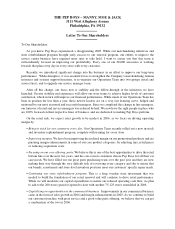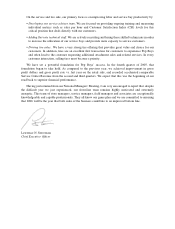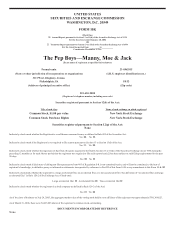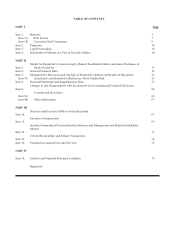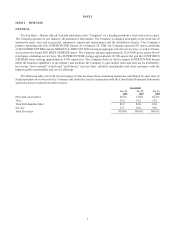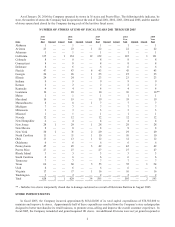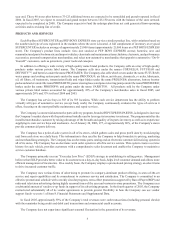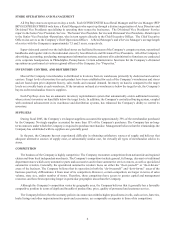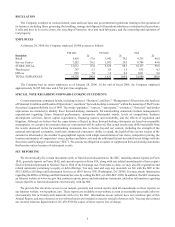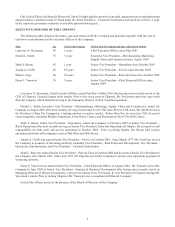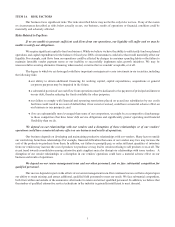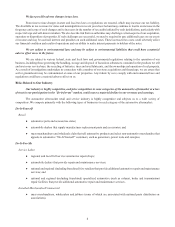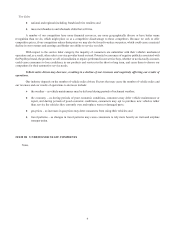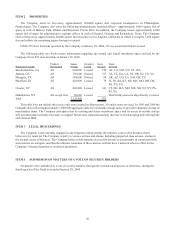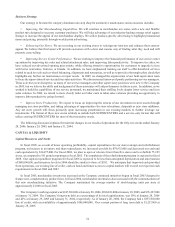Pep Boys 2005 Annual Report Download - page 9
Download and view the complete annual report
Please find page 9 of the 2005 Pep Boys annual report below. You can navigate through the pages in the report by either clicking on the pages listed below, or by using the keyword search tool below to find specific information within the annual report.4
STORE OPERATIONS AND MANAGEMENT
All Pep Boys stores are open seven days a week. Each SUPERCENTER has a Retail Manager and Service Manager (PEP
BOYS EXPRESS STORES only have a Retail Manager) who report up through a distinct organization of Area Directors and
Divisional Vice Presidents specializing in operating their respective businesses. The Divisional Vice Presidents- Service
report to the Senior Vice President- Service. The Senior Vice President- Service and Divisional Vice Presidents- Retail report
to the Senior Vice President -Operations, who in turn reports directly to the Chief Executive Officer. The Chief Executive
Officer also serves as the Company’s Chief Operations Officer. A Retail Manager’s and a Service Manager’s average length
of service with the Company is approximately 7.5 and 5 years, respectively.
Supervision and control over the individual stores are facilitated by means of the Company’s computer system, operational
handbooks and regular visits to the individual stores by Area Directors and Divisional Vice Presidents. All of the Company’s
advertising, accounting, purchasing, management information systems, and most of its administrative functions are conducted
at its corporate headquarters in Philadelphia, Pennsylvania. Certain administrative functions for the Company’s divisional
operations are performed at various regional offices of the Company. See “Properties.”
INVENTORY CONTROL AND DISTRIBUTION
Most of the Company’s merchandise is distributed to its stores from its warehouses primarily by dedicated and contract
carriers. Target levels of inventory for each product have been established for each of the Company’s warehouses and stores
and are based upon prior shipment history, sales trends and seasonal demand. Inventory on hand is compared to the target
levels on a weekly basis at each warehouse. If the inventory on hand at a warehouse is below the target levels, the Company’s
buyers order merchandise from its suppliers.
Each Pep Boys store has an automatic inventory replenishment system that automatically orders additional inventory
when a store’s inventory on hand falls below the target levels. In addition, the Company’s centralized buying system, coupled
with continued advancement in its warehouse and distribution systems, has enhanced the Company’s ability to control its
inventory.
SUPPLIERS
During fiscal 2005, the Company’s ten largest suppliers accounted for approximately 35% of the merchandise purchased
by the Company. No single supplier accounted for more than 15% of the Company’s purchases. The Company has no long-
term contracts under which the Company is required to purchase merchandise. Management believes that the relationships the
Company has established with its suppliers are generally good.
In the past, the Company has not experienced difficulty in obtaining satisfactory sources of supply and believes that
adequate alternative sources of supply exist, at substantially similar cost, for virtually all types of merchandise sold in its
stores.
COMPETITION
The business of the Company is highly competitive. The Company encounters competition from nationwide and regional
chains and from local independent merchants. The Company’s competitors include general, full range, discount or traditional
department stores which carry automotive parts and accessories and/or have automotive service centers, as well as specialized
automotive retailers. Generally, the specialized automotive retailers focus on either the “do-it-yourself” or “do-it-for-me”
areas of the business. The Company believes that its operation in both the “do-it-yourself” and “do-it-for-me” areas of the
business positively differentiates it from most of its competitors. However, certain competitors are larger in terms of sales
volume, store size, and/or number of stores. Therefore, these competitors have access to greater capital and management
resources and have been operating longer in particular geographic areas than the Company.
Although the Company’s competition varies by geographic area, the Company believes that it generally has a favorable
competitive position in terms of depth and breadth of product line, price, quality of personnel and customer service.
The Company believes that the warranty policies in connection with the higher priced items it sells, such as tires, batteries,
brake linings and other major automotive parts and accessories, are comparable or superior to those of its competitors.


